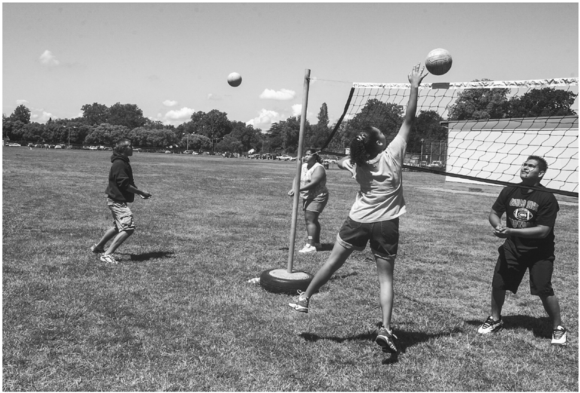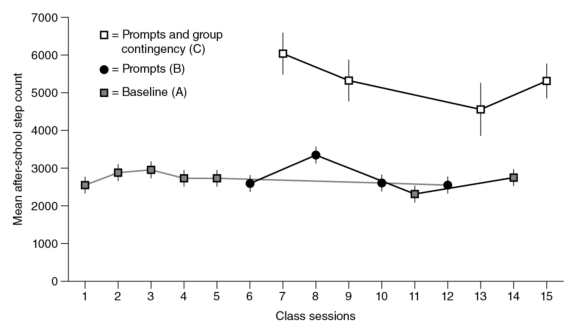Physical Activity Beyond Physical Education
This is an excerpt from Complete Guide to Sport Education 3rd Edition With Web Resource by Daryl Siedentop,Peter Hastie,Hans Van Der Mars.
The promotion of physical activity in physical education has become a major focus nationally and globally over the past three decades. As noted in chapter 3, the historic dominance of sport in the physical education curriculum has been pointed to as one of the main causes for many of the field's problems. This resulted in efforts to de-emphasize this focus on sport and increase the focus on fitness-related content. But there is no evidence that sport as program content in itself is the problem. Rather, we regard the manner in which sports have been taught in school physical education as the central cause. In this section, we show how Sport Education, if delivered effectively, can help students seek physical activity opportunities beyond the regular physical education lessons.
The ultimate goal for physical educators is to have their students seek out opportunities to engage in activities practiced (and learned) in physical education at times and in settings beyond the physical education lessons. For example, if students who learn to play badminton in physical education through Sport Education then go and seek out badminton before or during school (or at home), we can say that transfer has occurred.
Such transfer, however, does not happen automatically; it needs to be planned deliberately. That is, conditions need to be arranged so that when students are not in physical education lessons, they can still seek out needed equipment, find an appropriate location, and participate in activities taught in physical education lessons. Before school as well as during recess and lunch breaks are prime campus-based times when opportunities for physical activity can be created. In the next section, we provide various strategies that can help create the conditions for transfer from activity engagement in physical education lessons to other times on campus and beyond.

Sport Education, if delivered effectively, can help students seek physical activity opportunities beyond the regular physical education lessons.
Strategies for Increasing Physical Activity Beyond Physical Education Lessons
In Sport Education, teachers can make enormous contributions to ensuring that all students make use of physical activity opportunities beyond the regular physical education lessons. They can encourage out-of-class physical activity in various ways. Out-of-class (i.e., independent) physical activity opportunities can be made available on school grounds before school, during recess and lunch, and after school. Beyond the school grounds, opportunities exist at home, in structured sport programs, in parks, at community centers, and so on. In the following sections we offer strategies for structuring the season competition, setting up the campus environment, prompting and encouragement, and self-monitoring by students.
Structuring the Season Competition
With its strong emphasis on teams learning to work together, team competition within Sport Education seasons is likely one of the strongest incentives for students to seek out physical activity beyond the regular class sessions. Out-of-class physical activity can be built directly into the season competition. In addition to the points earned as a result of games played, duty team points, and fair play points, points for out-of-class physical activity can count directly toward a team's standing in the season competition. It is important to explain this dimension of the competition clearly in the initial class sessions of the new season. Students need to learn where they can get equipment, where it needs to be stored afterward, how they can earn physical activity points, and how they should report their out-of-class activities.
As for how such points can be earned, teachers can set a point value based on the number of minutes that a team practiced during recess or lunch period, such as one physical activity point for every five minutes of time spent in team practice. Physical activity points can also be awarded to individual team members, or on the basis of how many team members participated; that is, a team that has all of its members present and participating can be awarded additional points. The teacher is the best judge of the minutes-to-points ratio.
Just as physical activity engagement is not transferred automatically from the physical education lesson to out-of-class periods, it also does not automatically transfer to times and settings away from the school campus. This means that transfer of physical activity engagement beyond the school campus also needs to be considered. Physical activity during discretionary time outside of school (e.g., time spent at home) can be integrated into the seasonal competition in physical education. Such activity can be measured using multiple tools. For example, students can be asked to keep an activity log that provides a record of the nature of the activity and the amount of physical activity time. Or they can use pedometers that can track step counts. Upper-end pedometer models like the FITStepTM Pedometer (www.gophersport.com/assessment/pedometers) can also capture the amount time spent in moderate to vigorous physical activity (MVPA). Smartphone apps also offer physical activity tracking tools. Since many if not most secondary school-aged students own smartphones, such apps would be a good way to use technology in a physical education program. Parents of elementary school-aged students could be recruited to verify their children's daily physical activity records.
This team competition approach encourages students to work on either fitness- or technique-related activities in discretionary time outside of school. In order for this strategy to succeed, it is imperative that teachers explain to students what kinds of activities count toward daily and weekly accumulation of moderate to vigorous physical activity. Needless to say, the season can be set up so that any out-of-school physical activity can count toward the total team accumulation, or it might have to be a physical activity that is specific to the current season within the physical education lessons.
Hastie et al. (2012) demonstrated how the transfer of physical activity beyond the school day is more likely to occur as part of a jump rope season with fourth-grade students. In addition to providing verbal prompts for students to practice their jump rope skill, the teacher also provided a team bonus points challenge on selected days of the season. When students practiced their jump rope skills at home and met the amount of time spent practicing set by the teacher (and certified by their parents) they earned bonus points that counted toward the team's standing in the competition. As can be seen in figure 6.4, on days when the prompting plus bonus points condition was in effect, the average step count (the indicator of students' physical activity levels) was significantly higher than for the baseline and prompting-only condition.
The use of group contingencies is an excellent example of how out-of-class physical activity can be encouraged and reinforced. Moreover, it represents an authentic means of embedding it in a sport season and supports transfer from physical education classes to other times and settings.

Figure 6.4 Mean after-school step counts across conditions.
Reprinted by permission from P. Hastie et al. “The Effects of Prompts and a Group-Oriented Contingency on Out-of-School Physical Activity in Elementary School-Aged Students” Journal of Teaching in Physical Education 31 (2012): 131-145.
Setting Up the Campus Environment
In all likelihood, merely prompting students to go out and be active on their own is not enough; they need to be supported in their out-of-class physical activity as well. You can help shape the school environment by providing such support in ways that address three key issues: access, equipment, and adult supervision
(Lorenz et al., 2017).
First, you can create access by designating the gymnasium or parts of the outdoor activity venues as areas for independent team practices. Clearly marked signage can indicate the designated team practice area, setting it apart from other activity areas that can be used for free play by other students.
Second, you can make season-specific equipment available for use before and after school by preparing an equipment cart that is placed in the same spot every day near a designated activity area. For example, through grants or by working with Parent Teacher Organizations, all the elementary school physical education programs in Chandler, Arizona, were provided such carts, with the accompanying equipment dedicated solely to supporting campus-based physical activity beyond the physical education lessons.
Team equipment managers can be made responsible for the carts, overseeing proper use of the equipment, reporting any lost or damaged equipment, and returning the cart at the end of practice.
Some teachers may argue that equipment will get damaged, lost, or mistreated if students are given the role as equipment managers. But the proper use, treatment, and management of equipment can be built directly into the season's point system through the use of fair play points that help determine the season's champion. Repeated mistreatment or loss of equipment could result in loss of fair play points or not being allowed to practice outside of class. Once teams understand that they can earn additional fair play points, they will be more inclined to use and manage equipment appropriately.
In order for team practices held outside of physical education classes to be productive, team coaches can be asked to provide written documentation on who attended team practices and on what did or did not work well during the out-of-class team practices. Such documentation would be excellent evidence about team performance that can be shared in the team's portfolio.
Third, you can recruit other adults (e.g., playground monitors) who have lunch duty by making them aware of your goal of encouraging physical activity and seeking their assistance in this process. Typically, adult monitors see themselves as responsible only for safety and overall conduct. As long as students act safely and avoid inappropriate conduct, therefore, these monitors tend to remain passive during recess or lunch periods, and yet they are also a built-in support resource. For example, they can sign the team-based physical activity log to certify that members of a team came together to practice. For them to take on this added task of monitoring team activities they will require professional development. The willingness of physical education teachers to communicate with other staff members and teachers on campus, coupled with a little training (perhaps at staff meetings), can go a long way toward creating and supporting students' physical activity opportunities throughout the school day.
Fourth, lunch periods provide ample time for team coaches to organize one good activity that can help the team prepare for the season or for the next game. Such practices should consist of informal (but purposeful) games that are typical of the natural play patterns when children and youth gather to play a game. We strongly agree with Launder and Piltz (2013), who argued that it is within this context that learners become players through experimentation. Team coaches can be encouraged to use the team practice cards and action fantasy game cards provided in the web resource for chapter 7. Note that introducing students to a particular activity during physical education class provides a perfect opportunity for you to encourage teams to engage in that same activity during out-of-class times.
When teams play and practice by themselves, they invariably have to work through problems that may emerge between team members. A central characteristic of fair play is that all team members show up for such independent team practices. If a player misses multiple practice sessions, the team has to decide how to address this problem.
SHOP

Get the latest insights with regular newsletters, plus periodic product information and special insider offers.
JOIN NOW
Latest Posts
- Authenticity was key to McKinney’s NIL success
- AI—A new tool for sport PR pros
- Essential skills for sport PR practitioners
- Employ these tactics when pitching a story to the media
- How does ergonomic analysis and intervention enhance safety and reduce injury risk?
- Common movement patterns in competitive cycling


